Orthodontic Treatment
Orthodontics is the branch of dentistry that deals with the prevention, detection and treatment of deformities of the jaws and teeth.
Basically, any dentist may treat his patients orthodontically, but only an orthodontic specialist has several years of training in this field, has passed a specialist examination before the Chamber of Dentists and deals exclusively with orthodontics.
Your dentist in this practice, Dr. med. dent. Jost, is such an orthodontic specialist.
Diagnosis
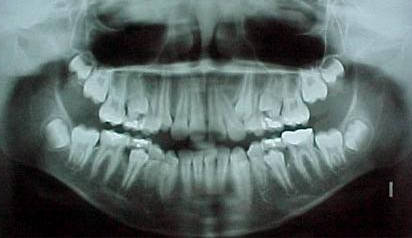
Panoramic radiograph, photo: www.ortodoncia.ws
Before any orthodontic treatment, a detailed diagnosis must be made. This consists of a medical and dental health history (anamnesis), a physical examination, a functional and model analysis (by means of a mold of the teeth) and a radiographic examination. With these findings the positional relationship between the upper and lower jaw can be analyzed in detail. Simultaneously, the periodontium is assessed and the dentition stage evalued.
At what age should one treat?
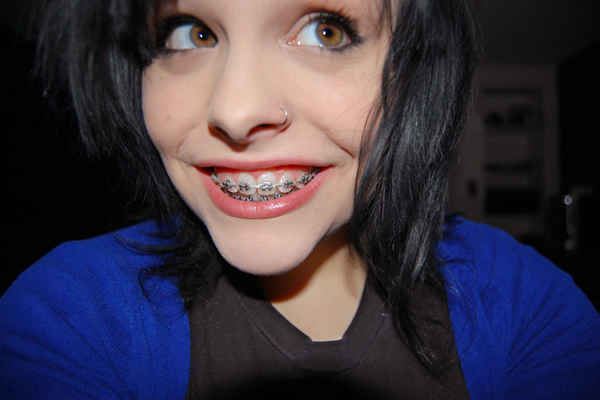
Girl with braces, photo: Zoe
The timely diagnosis enables an optimal start of treatment, which can often shorten the duration of treatment and reduce its amount. Therefore, children should be examined before the age of 10 in case of any suspicion of misaligned teeth. The treatment is preferentially carried out using the natural growth spurts from 9 to 14 years of age.
However - contrary to older opinions - an orthodontic treatment is possible at any age, even in adult patients. This applies in the event that an earlier treatment was missed or has failed, in case of pathological tooth migration, and in the context of a disease of the gums. These treatments, however - apart from exceptions - are not covered by public health insurance.
Treatment methods
Dental equipment for the correction of misaligned jaws and teeth are collectively called braces. A typical treatment takes an average of 2-4 years, the duration depends on the type and degree of the misalignment, the braces used during therapy and the patient's cooperation.
Wired braces
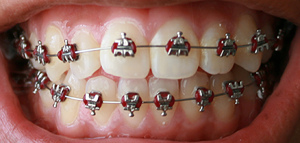
Metal wired braces, photo: Monica Nguyen
Most common are fixed traditional metal wired braces (in Germany called Brackets). They are attached to the tooth's surface by special bonding techniques and thus form an anchor point for the movement of the teeth.
Wired braces can be distinguished according to where they are attached to the tooth. Mounted on the outer surface, i.e. directed to the cheek, they are called buccal braces (see image above). If they are attached to the inner surface of the teeth, facing the tongue, they are called lingual braces.
Lingual braces
In case of a lingual approach, a fixed brace is attached to the inside of the teeth, thus being virtually imperceptible from the outside. Since the fine adjustment of the teeth is often more difficult with this technique than with buccal braces, the lingual technique must often be combined with a final clear-aligner treatment (see below).
Thus, both the duration of treatment at each appointment and the total treatment time are extended. Therefore, the costs are in general considerably higher compared to the conventional treatment with braces on the outer side of the teeth.
Clear-aligner treatment
Relatively new are correction devices (aligners) made of transparent plastic. Unlike traditional braces clear aligners have no adjustable elements. Instead, a mold of the patient's teeth is taken, which is used to create a digital tooth scan. Then a computerized model of the desired teeth positions is derived and stages between the current and the intended teeth positions are calculated and aligners are created accordingly.
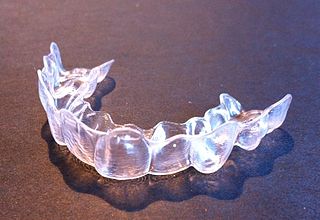
Invisalign orthodontic aligner, photo: Smikey Io
Each aligner is worn consecutively for 2 weeks, about 20 hours per day. Up to 36 aligners are used over a period of 9-18 months. The aligners are more noticeable than lingual braces but less than buccal braces. They can easily be removed during meals and for cleaning of the teeth. Pronunciation can be affected at the beginning of the treatment, but usually improve with time.
Removable braces
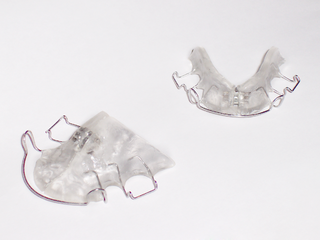
Removable brace, photo: Metoc
Removable braces are used as active plates for upper and lower jaws and functional orthodontic devices. Active plates are particularly suitable for children in the mixed dentition stage. In the permanent dentition active plates are used only for smaller tooth movements.
Temporomandibular joint dysfunction
Temporomandibular joint dysfunction (TMD) is an umbrella term covering dysregulations of muscle and joint function of the jaw joints, which may be structural, functional, biochemical and psychological in nature.
Find more on our dedicated page for TMD.